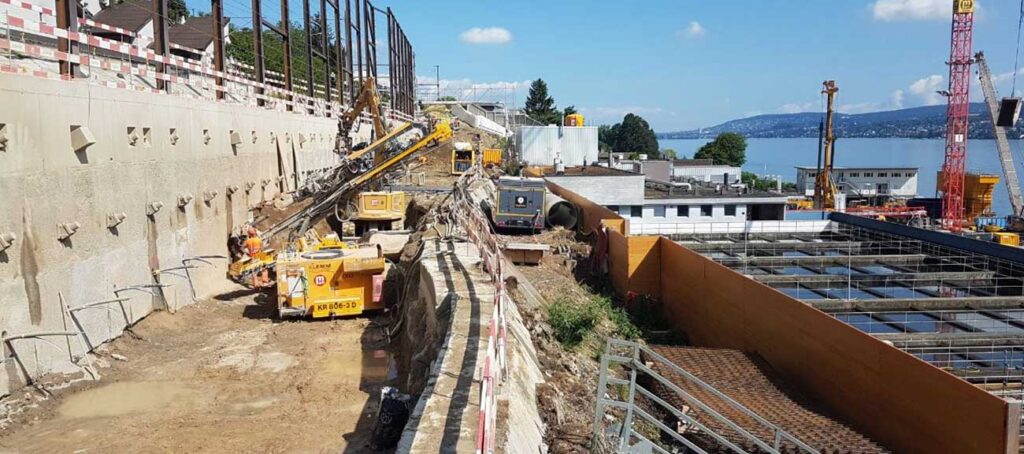Station d’épuration des eaux usées Zimmerberg

Les stations d’épuration vieillissantes de Horgen et de Thalwil, situées près de Zurich, en Suisse, doivent faire l’objet d’une rénovation approfondie afin d’améliorer leur efficacité de nettoyage. Les deux stations vont donc être fusionnées. La nouvelle station d’épuration moderne de Zimmerberg (ARA) traitera les eaux usées de 78 000 habitants et de l’industrie à partir […]
360° Chaine MD-profile

Codes de référence: S431HD, S432HD, S431HA, S432HA Les sondes MD-Profile 360° sont conçues pour être placées à l’intérieur de tubes à l’intérieur lisse (‘flush’ tubes sans rainures).360° MD-Profile gauges are designed to be placed within internally flush pipes. Le système est adapté aux applications géotechniques et structurelles, où un profil précis en vertical ou en […]
FAQ#116 – How do I configure a WR-Log digital node to read RS485 Sisgeo TIMED sensors?
Sisgeo digital instruments can operate in two powering modes: TIMED or ALWAYS-ON (for more information see F.A.Q.#094).A string of mixed instruments consisting of TIMED gauges and ALWAYS-ON gauges cannot work.The first thing to do is therefore to check that ALL connected instruments in your array are set to TIMED mode.You can check the powering mode […]
FAQ#110 – What’s the purpose of the linear and polynomial factors written in the Calibration Reports?
Utilize the Linear Sensitivity Factors (A, B) and Ploynomial Sensitivity Factors (A, B, C, D) of the Calibration Reports permit to obtain readings in engineerig units with a maximum error as for the Calibration Report. In the case of analogue gauges, the factors shall be applied on the electrical readings (i.e. mA, mV, digit, etc…) […]
FAQ#095 – How long does a chain of digital sensors take to be read?
It mainly depends from the powering mode of the gauges (refer to FAQ#094 for the description of the powering modes). AN EXAMPLE WILL BETTER CLARIFY THE ANSWER. In a batch of 240 gauges, unless otherwise requested by the Customer, the addresses are settled from #001 up to #240. In a borehole is installed a chain of 30 […]
FAQ#094 – Which are the available powering modes for SISGEO digital sensors?
All SISGEO digital gauges can be settled in two different powering mode: The STANDARD powering mode is ALWAYS ON, so unless otherwise requested by the Customer, the sensors are settled as default in ALWAYS ON.
FAQ#077 – Quelles sont les longueurs maximales de câble depuis l’instrument jusqu’à l’enregistreur de données?
Les longueurs de câble maximales dépendent de plusieurs facteurs, et en premier lieu le mode d’installation et les protections de câble (blindage, terre, etc…). En supposant que les instruments sont installés selon les règles de l’art, les suggestions suivantes devraient être prises en compte pour la longueur maximale de câble: INSTRUMENTS NUMERIQUES: voir FAQ#073 INSTRUMENTS […]
FAQ#076 – Pourquoi est-il nécessaire d’ajouter une résistance de terminaison au dernier capteur numérique de chaque chaîne RS-485?
Tous les instruments numériques SISGEO (IPI, clinomètres, H-Level…) utilisent le protocole de communication série RS-485. Le protocole RS485 requiert l’ajout d’une résistance de terminaison. La connexion recommandée pour une chaîne utilise des nœuds « point à point » (multidropped) en mode bus (line). Les connexions réseau en étoile, circulaires ou ramifiées ne sont pas recommandées. […]
FAQ#075 – What parameters are saved in SISGEO digital sensors? What information must the Customer provide when ordering?
All SISGEO digital sensors (e.g. IPI, BH Profile, MD Profile, LT Inclibus, Tilt-meter, RDS, H-Level, etc.) use the Modbus communication protocol over RS-485 serial. SISGEO digital sensors are connected to each other with a single signal cable. The parameters that are configured at the factory for each digital sensor are as follows: Upon confirmation of […]
FAQ#073 – Quel est le nombre maximal de capteurs numériques (RS-485, Modbus), le nombre maximal de chaînes et la longueur maximale du câble dans un réseau RS-485?
Last update: October 2021 All the SISGEO digitized sensors utilize a RS485 interface with Modbus protocol. 1.The maximum number of digitized sensors in a RS-485 network are 247 (theoretical) 2.The maximum number of digitized sensors chains that is possible to connect to Modbus master unit (as OMNIAlog or miniOMNIAlog) are 4. 3. About the maximum […]








